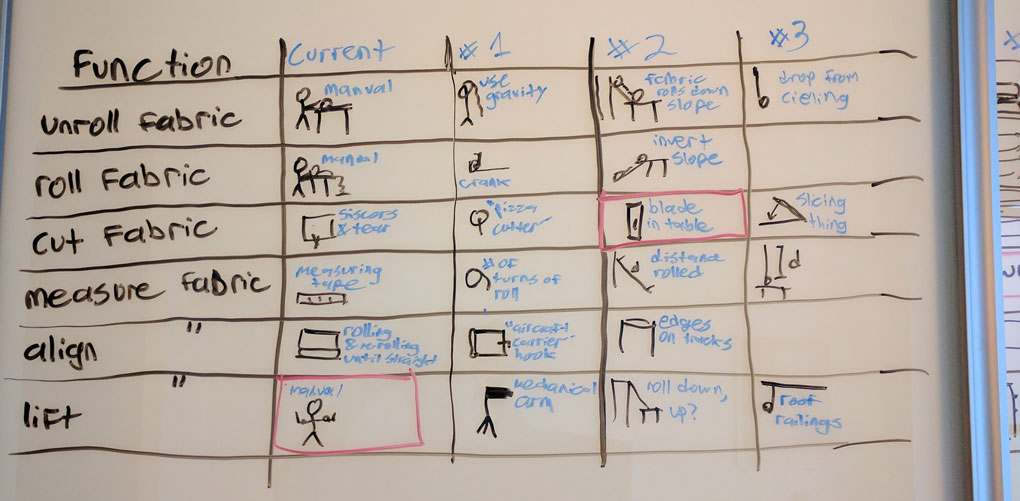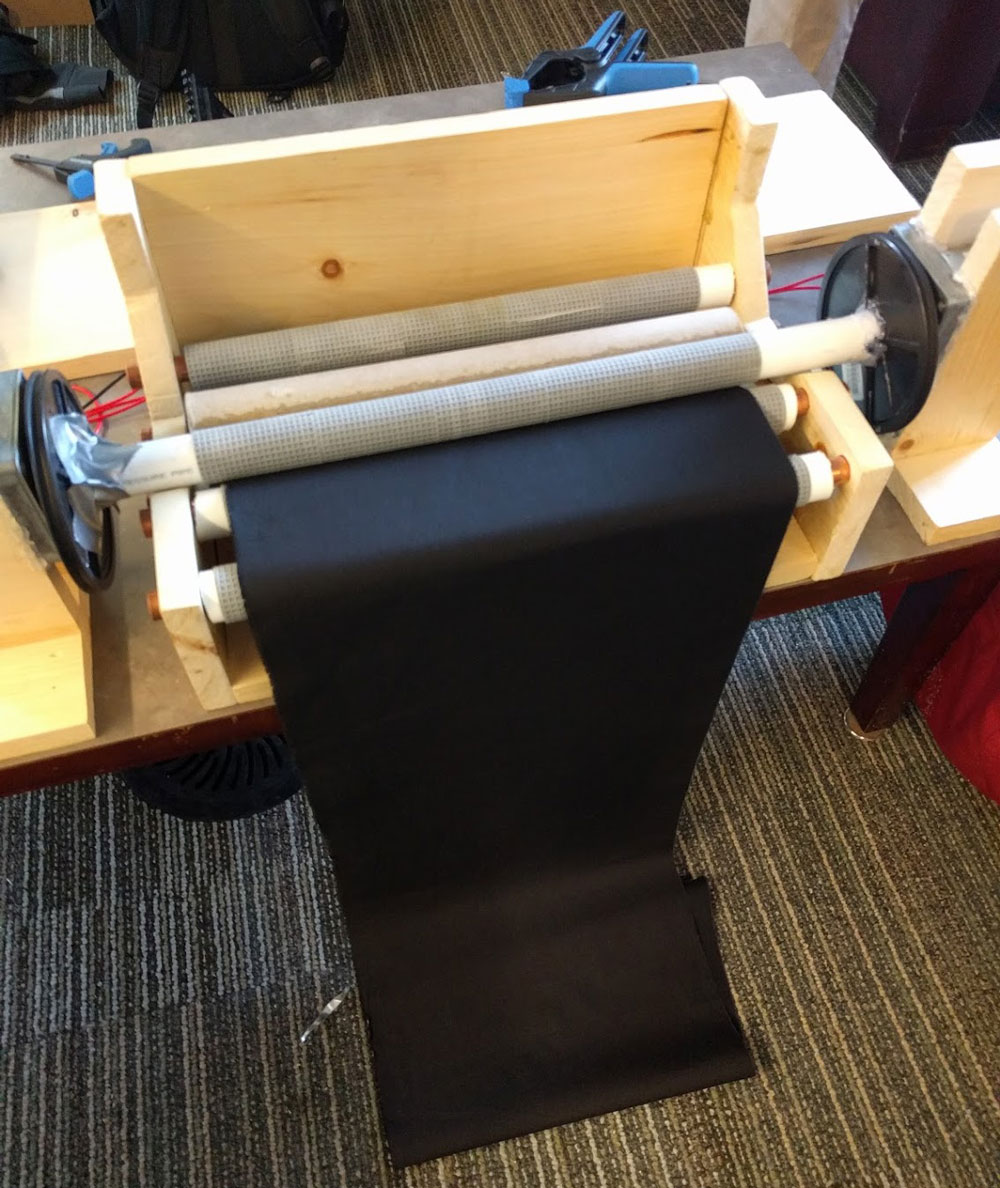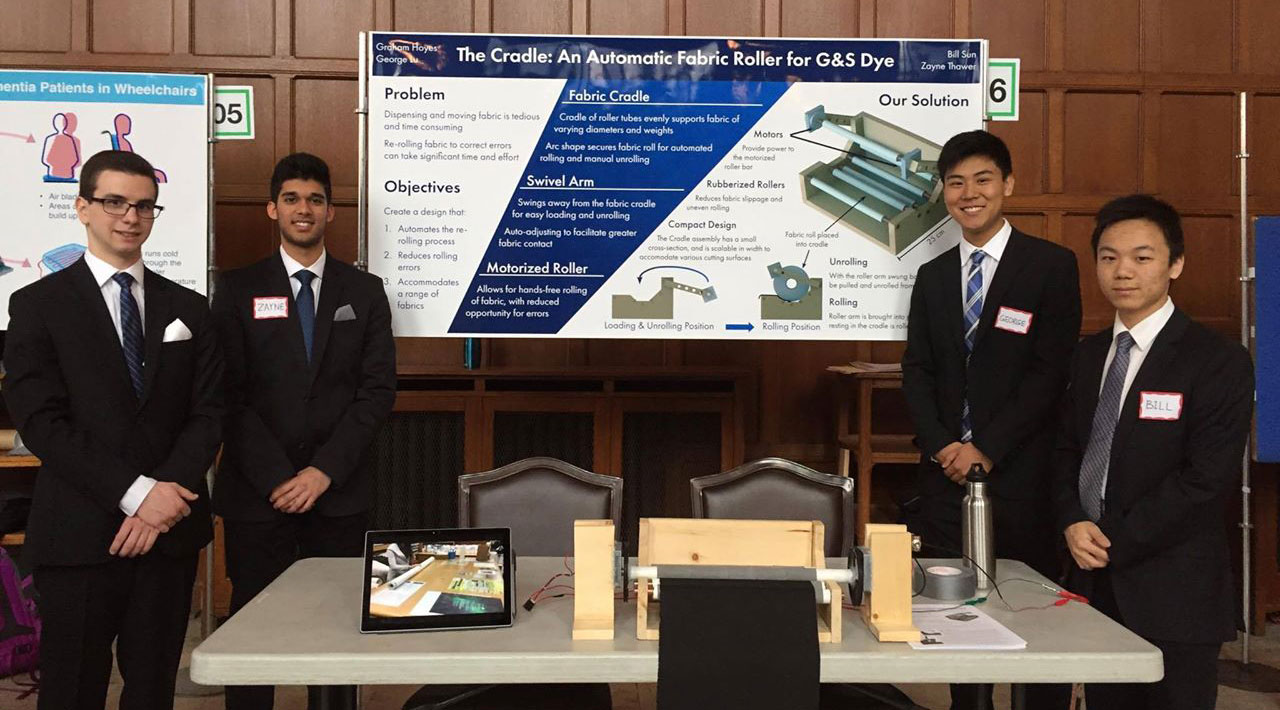The Cradle: An Automated Fabric Roller for G&S Dye
Time frame: March-April, 2017
Project type: Team
My responsibilities: Research, stakeholder engagement, design, prototype building, poster design
Praxis II is the culminating design course for first-year Engineering Science students. It builds on the basics learned in Praxis I, but focus more heavily on continued working relationships with stakeholders, and producing more concrete results. In the first phase of the course, each team works with a community of their choosing in the GTA to develop a Request For Proposal (RFP) document, which requests proposals to improve some aspect of the community as identified by the authoring design team. For the second phase of the course, 8 RFPs are chosen to go forward, and teams chose one to work with through to the final design showcase. My team chose to work with G&S Dye to develop an automated device to roll fabric. The original RFP authors had identified two areas that could be improved at the store: the "Retrieval process" of retrieving fabric from storage, and the "Dispensing process" of unrolling fabric, cutting it for customers, and re-rolling it back to be stored. A one-page summary of our solution can be read here.
Having learned previously the importance of interacting with stakeholders directly, early on into the process we visited the store to talk with the manger (and only employee). When we were visiting, she happened to be rolling up a new shipment of fabric. We learned that this is both a physically taxing process and is quite time-consuming, and prevents her from interacting with customers as much or performing other tasks within the store. As such, our team scoped down to develop a device that would automatically roll fabric at the store without requiring ongoing interaction from employees.
Since this was our culminating project of the year, each of us was going in with a fully-developed design process we could follow along the way. After analyzing the RFP and visiting the store to develop requirements of our own, we started researching and exploring potential solutions. Initially, we had eliminated the possibility of using industrial-scale fabric rollers as they would not have been able to fit in the store, and would have been far too expensive. Using a number of tools, including the morph chart shown below, we diverged to generate as many potential solutions as possible.

Part of a Morph Chart used to help generate and organize ideas for how we could solve the fabric rolling design problem.
Once we had converged down to some design features, I started building our first working prototype. This was the first electro-mechanical prototype I had built this year, so my skills required some fine-tuning. We obtained two different kinds of motors, one for rolling the fabric and another for feeding it. I then build an H bridge circuit to change the direction of the motors for either rolling or unrolling. Though a lower-fidelity prototype, we did learn a lot about our ideas from it. Most importantly, using wheels to guide the fabric was not an effective solution, as it often led to bunching or even rolling of the fabric if they weren't perfectly parallel or rolling at the same speed. At this point, we're cycling between Phase 2 and Phase 3 in my design process to generate more solutions and iterate on previous designs based on what we had learned.

Our first prototype of a fabric roller, using two large motors to spin the fabric bolt and two smaller motorized wheels at the end of the table to guide the fabric.
After our Beta presentation of our concept, we modified a number of design choices. Most importantly, we decided to look back to industrial designs for inspiration to solve our wheel problem. The obvious solutions was to use roller bars instead, a feature which worked quite well for us. We also decided to design a "cradle" to hold the fabric rolls, instead of a bar that went through the center of the bolt. This helped accommodate the rolls as they grew in size, and made use of the device much easier. We then decided to direct much of our efforts to building a functional prototype on which we could test a number of our design features.

Our Fabric Cradle prototype, featuring a cradle of rollers to hold the fabric and a motorized roller bar to spin the roll.
Once the prototype was made, we were able to perform a number of tests on it to make sure it was meeting our objectives. We tested repeated rolling at varying speeds, how often defects occurred, what kind of defects occurred, amongst other aspects of its performance. Importantly, we identified which issues were caused by the design, and which were just a result of the construction of the prototype (which was done without access to a machine shop).

My team and I with our design and accompanying poster at our final design showcase.
Next Steps
Our team's goal was to develop a design and prototype that we felt could be implemented in the store within a reasonable time frame, and would positively impact the experience of employees at the store. We believe we were successful in this regard, and with some improvements, our design could be implemented.
First off, more research and testing into ergonomics and safety is necessary to push the design forward. As is, we focused on creating a device that could effectively roll fabric. Now we need to plan how the user is to interact with the device, and optimize it for their safety. Second, more resources would be required to build a higher-fidelity prototype for final testing. We had access to hand tools for constructing our first prototype, but would require access to more precise tools in a machine shop to have better results. Following that goal, I plan to obtain certification this shortly that would allow me access to the Mechanical Engineering machine shops at U of T. Finally, while presenting our design to the owner of the store, he expressed much more useful the product would be if it could also measure the fabric it was rolling. Our device could easily roll and unroll fabric at the store, and if it could also measure how much it rolled it could be a major time saver when taking inventory. Since our design uses a roller bar of fixed diameter to roll the fabric (that is always tangent to the roll), a simple rotary motion sensor could be installed that would correlate number of revolutions of the motorized roller to the length of fabric rolled.
Lessons Learned
The importance of prototyping was once again re-affirmed through this design project. Prototyping early on allowed us to identify flaws with our design, and to iterate on them to develop a better product. I also gained more experience interacting with stakeholders who were total strangers to me, as a result of being brought into the RFP with little preparation. Meeting with the stakeholders at the store early helped us identify an area we felt would be of actual positive impact to the store. Indeed, when we brought our final design to the owner of the store, he was enthusiastic with our design and expressed how with some minor modifications it could make a significant impact at the store.
This project was also the only one of the year that required making a poster to present our ideas. I was responsible for making the poster, and chose to use Adobe InDesign to do so. It had been a few years since the last time I used InDesign for a major project, so I decided now would be a good opportunity to refresh my skills. It was a good exercise in graphic design, where I had to balance visual information with text on a 6'x3' poster, which is larger than I've ever worked on before. I did my best to follow some of the best practices of using InDesign, including using layers to separate elements and the use of styles to help with the frequent reformatting of text. A full-scale version of the final poster, which I am quite satisfied with, can be found here.